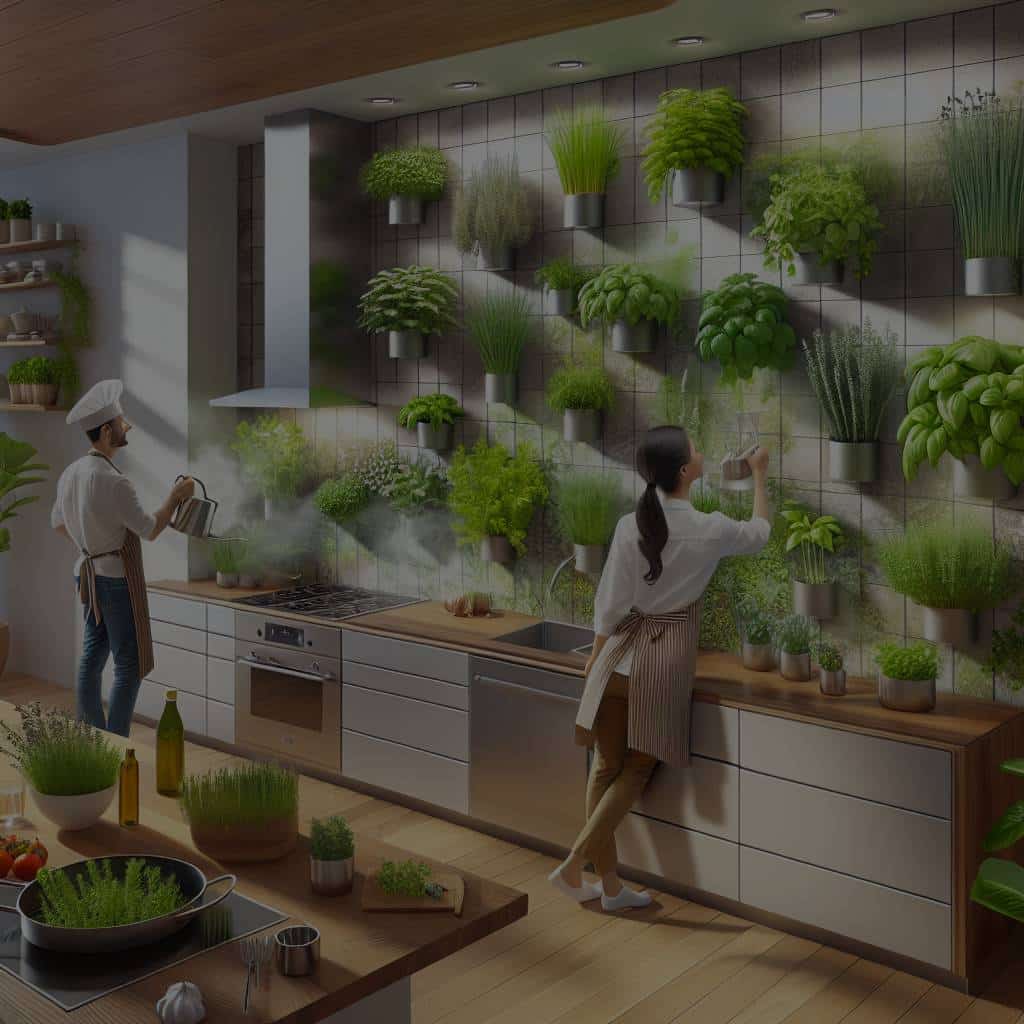How to Integrate a Vertical Herb Garden into Your Kitchen Design?

Creating a vertical herb garden in your kitchen can transform the space, bringing a breath of fresh air and a sense of vitality into your home. Fresh herbs not only add a culinary advantage to your kitchen but also offer a visual feast to the eye. But how do you incorporate this living piece of art into your kitchen design? Let’s delve into the world of vertical herb gardens and discover the steps to create the perfect, thriving herb wall in your kitchen.
Choosing the Right Herbs for Your Kitchen Garden
Before we dive into the design process, it’s crucial to choose the right herbs for your kitchen garden. Not all herbs will thrive in an indoor setting, so selecting the correct plants is vital for the success of your vertical herb garden.
A lire en complément : How Can You Create a Self-Watering Plant System for Your Home Office?
Common kitchen herbs like basil, parsley, thyme, and rosemary are popular choices due to their culinary versatility and relatively easy maintenance. They also have pleasant aromas that will enhance the atmosphere in your kitchen. However, you should also consider factors like light and water requirements, as well as the specific conditions of your kitchen. Herbs that love lots of sunlight, like basil, will need a spot near a window or under a grow light.
Remember, too, that your herbs will need good-quality soil and sufficient water to grow. Consider investing in self-watering pots or a drip irrigation system if you’re concerned about maintaining a regular watering schedule.
A lire également : How to Craft a Vintage-Inspired Home Office with Antique Finds?
Designing Your Vertical Herb Garden
Once you’ve chosen your herbs, it’s time to design your vertical garden. The design largely depends on the space available in your kitchen. Small kitchens may require a more creative approach, but don’t let this deter you. Vertical herb gardens are perfect for small spaces, as they optimize wall space instead of counter or floor space.
If you have a sunny kitchen wall, consider attaching wall-mounted plant pots or fabric pocket planters. If your kitchen lacks natural light, install a grow light system to ensure your herbs get the light they need.
Consider also the style of your kitchen. The garden should complement the existing elements rather than clash with them. Choose pots and planters that match your kitchen aesthetics — whether that’s sleek and modern, rustic and cozy, or chic and vintage.
Implementing Your Vertical Herb Garden
Now that you have the design and plants ready, it’s time to implement your vertical herb garden. Start by preparing the designated wall. This might involve installing a trellis or a vertical planter. Ensure that whatever system you choose can support the weight of the plants, soil, and water.
Next, plant your chosen herbs in their pots. Ensure each plant has enough soil and space to grow. Remember, some herbs will grow larger than others, so plan accordingly.
Once the herbs are planted, attach them to your vertical structure. Ensure they are secure and won’t fall off.
Caring for Your Vertical Herb Garden
A vertical herb garden, like any garden, requires consistent care and attention. Watering is key: too much water can lead to root rot, while too little can cause your herbs to wilt and die. A drip irrigation system can be a useful tool to ensure your plants receive the right amount of water.
Sunlight is another important factor. Most herbs need at least six hours of sunlight a day, so make sure your garden gets enough light, whether it’s natural or from a grow light.
Finally, regular pruning will keep your herbs healthy and productive. Not only does this encourage new growth, but it also prevents the plants from becoming too large and overcrowded.
Enjoying the Fruits (or Herbs) of Your Labor
Finally, remember to enjoy the fruits of your labor. A vertical herb garden in your kitchen not only provides fresh, aromatic herbs for your culinary creations but also adds a vibrant, living piece of decor. As you use your herbs in your cooking, you’ll not only taste the difference, but you’ll also feel a deep sense of satisfaction knowing that you nurtured those plants from seed to harvest.
While integrating a vertical herb garden into your kitchen design might seem daunting, the process is fairly straightforward. With careful planning and regular care, you can create a verdant, thriving garden that not only enhances your kitchen decor but also provides you with a bounty of fresh herbs for your culinary endeavors.
Enhancing Your Kitchen with Biophilic Design
Integrating a vertical herb garden into your kitchen is a perfect example of biophilic design. Biophilic design is the concept of incorporating nature into the built environment. Not only does this approach have positive effects on your health and wellbeing, but it also improves the aesthetic appearance of a space.
By choosing to include an indoor herb garden in your kitchen, you’re implementing aspects of biophilic design. The greenery of the herbs will brighten your kitchen, making it more welcoming and alive. A vertical herb garden can also act as a focal point, drawing the eye and adding depth to your kitchen space.
For a more dramatic effect, consider creating a plant wall. This can be achieved by attaching multiple vertical planters to your wall, forming a lush, green tapestry of fresh herbs. Not only is this a stunning visual feature, it also provides you with easy access to a variety of herbs for your culinary creations.
Consider also other elements of your kitchen, such as lighting and ventilation. The quality and quantity of light that your herbs receive will directly affect their growth. Similarly, good air circulation helps to prevent the occurrence of pests and diseases.
Remember to use high-quality potting soil for your herbs. This will provide them with the necessary nutrients and promote healthy growth.
Image credit: Show a vibrant, thriving vertical herb garden on a kitchen wall.
Conclusion: Reaping the Benefits of a Kitchen Herb Garden
In closing, a vertical herb garden in your kitchen offers a variety of advantages. From a design perspective, it adds a unique element of nature that’s both visually appealing and engaging. The fresh, aromatic herbs not only enhance your dishes but also fill your kitchen with delightful scents.
Regular interaction with your herb garden, be it watering, pruning, or simply picking herbs for your meals, can also have therapeutic benefits. This direct engagement with nature promotes relaxation and can relieve stress, contributing to an overall sense of wellbeing.
Incorporating a vertical herb garden into your kitchen design requires planning and care, but the rewards are well worth the effort. Not only will you enjoy the visual enhancement it brings to your kitchen, but the fresh herbs will also elevate your cooking to new heights.
So, embrace the world of indoor herb gardens and bring a touch of nature into your kitchen. Whether you have a spacious kitchen or are working with limited space, a vertical herb garden can be a practical and beautiful addition to your home. It’s time to bring your culinary skills and interior design aspirations together in a harmonious blend of nature, design, and functionality.
Remember, the vertical herb garden in your kitchen is not just about growing herbs; it’s about cultivating a lifestyle. It’s a reflection of your commitment to healthy living, sustainability, and a love for fresh, homegrown food.
